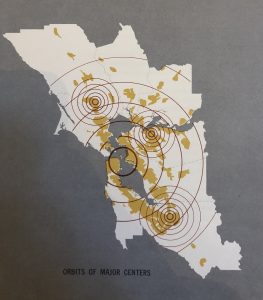
Photo Credit: Regional rapid transit; a report to the San Francisco Bay Area Rapid Transit Commission, 1953-1955.
One of my favorite icebreaker questions at Columbia is “What’d you write your P3 on?” The P3, for those uninitiated, is the Phase 3 essay in University Writing, a Core course required for all Columbia College and Engineering students. The course entails four essays: the first, a “critical response” essay, analyzing a problematic or unclear moment in a text; the second, analyzing an exhibit and defending a claim about it; the third, a longer research paper that requires you to use a variety of sources to make a claim about a controversy or exhibit; and the fourth, an op-ed. The last is probably the flashiest—some students end up publishing P4 essays in newspapers. But the third is, at its best, a labor of love: you’re given a fairly loose set of constraints and asked to come up with an argument you care about, to invest a sizable amount of time in it.
I like hearing what people wrote their P3 about for the same reason I like hearing why they chose Columbia or the story behind their dog’s name. It isn’t just the final product that tells you about the person who made the decision, it’s the process of decision-making itself. For instance, I’m maybe the only Columbia student ever (I kid, obviously) who didn’t actively want to move to New York City. Was it a wise decision to move to New York despite not knowing how I felt about it? Maybe. I now can’t imagine going to school anywhere else, and that shift is as illuminating as the simple fact that I like Columbia. On the other hand, I arrived at my P3 topic, the racist history of transit infrastructure in the Bay Area, by noticing something that felt pressing in New York, and wondering if and how it played out in my hometown. Looking back on it, spring of freshman year, I was newly interested in two things, apparently: inequality in urbanism, and re-examining California from an outsider perspective.
So let’s say you’re a freshman and sitting down to write a P3. Where do you go from here? Your instructor will give you a fair amount of guidance, but part of what makes the P3 daunting, besides citations, is the amount of self-guidance necessary. Some questions you might ponder: what don’t you know about New York? What don’t you know about your hometown? What was the last movie you watched that really bothered you? One of my friends was curious about an issue related to a service project he was working on and used the P3 as an opportunity to dedicate his academic time to learning more about it. Another, in a music-focused section, drew inspiration from her life-long obsession with Kate Bush.
Whatever avenue you choose, one of the biggest challenges of the P3 is being sufficiently specific. Freshman year, at its best, grabs you by your shoulders and joyfully and sternly informs you that the world is a much bigger place than you had previously thought. The P3 is an opportunity to winnow your reaction to that down to specifics. One issue, in one place; one question, for one artist; one paradox, for one area of politics. That specificity will seem like a challenge when you start out, but it’s also a chance to start to define your identity as a student researcher.
